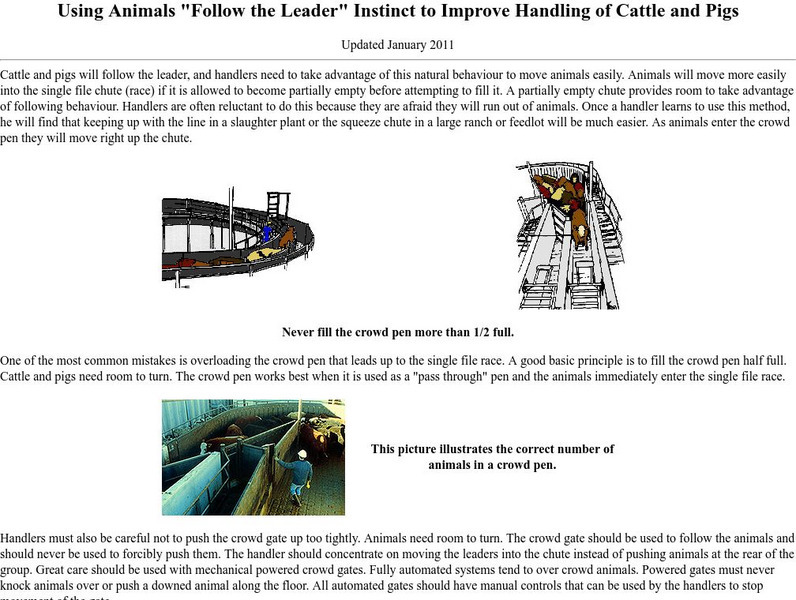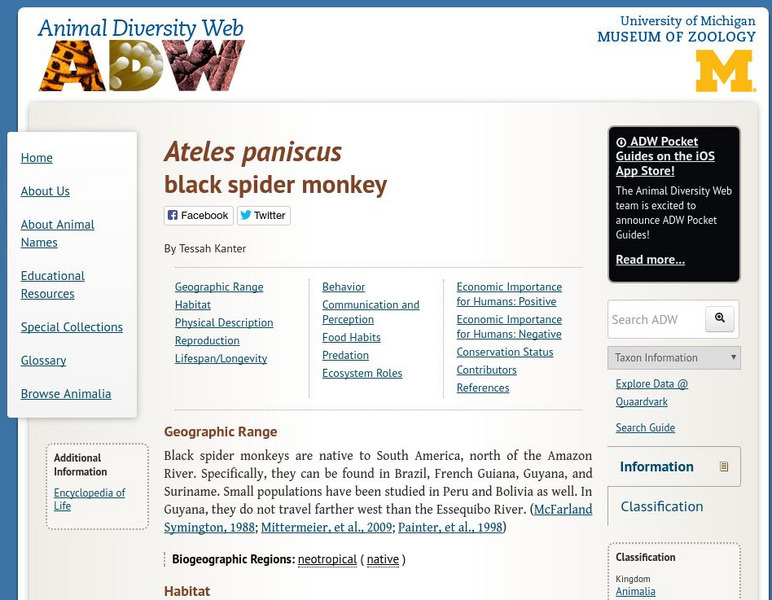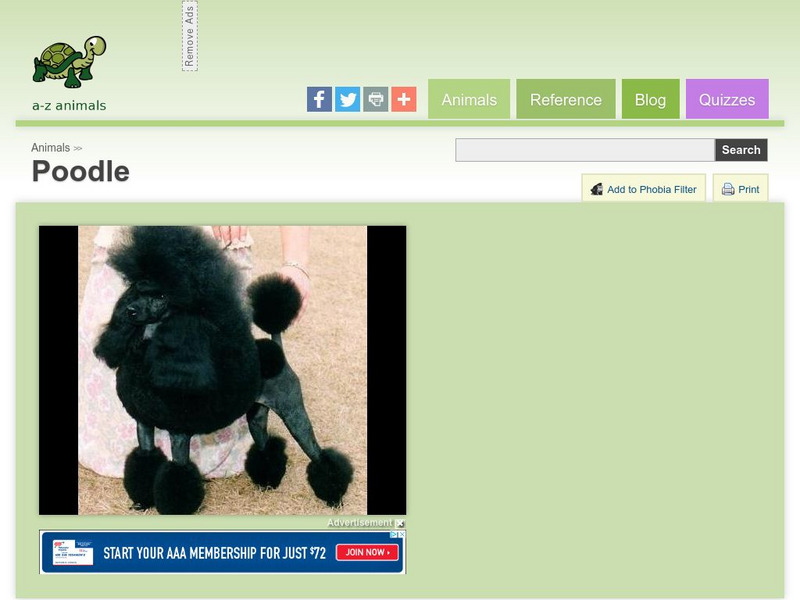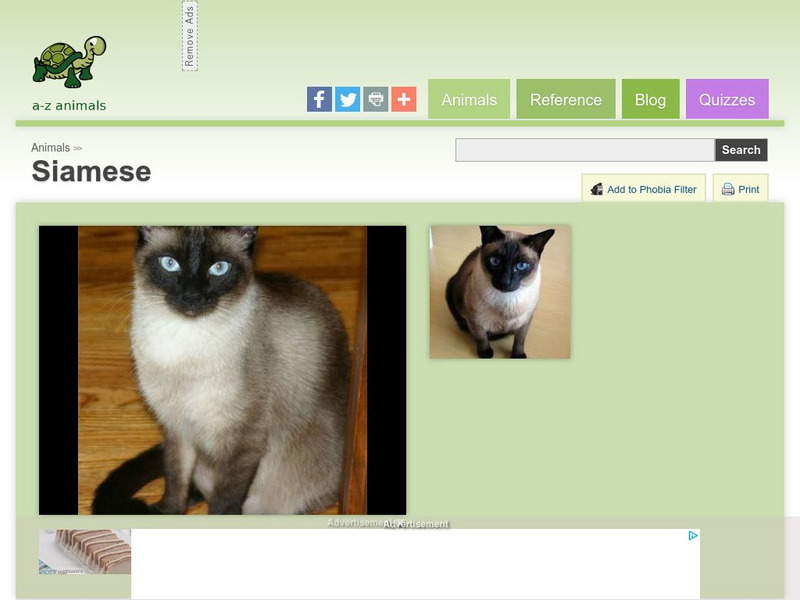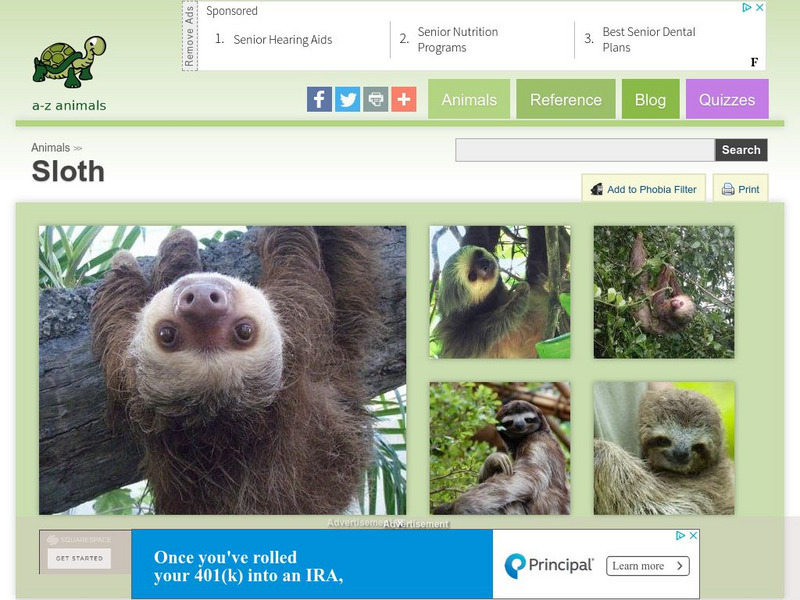Hi, what do you want to do?
PBS
Pbs Learning Media: How Animals Care for Their Young
In this interactive lesson, students learn that animals take care of their young in many of the same ways the adults in their lives take care of them.
Annenberg Foundation
Annenberg Learner: Journey North: A Global Study of Wildlife Migration and Seasonal Change
Here you can view maps showing the migratory paths of dozens of animals across the northern hemisphere, report a sighting of one of the animals listed in the database, and much more.
Other
Animal Info: Dama Gazelle
This site contains a variety of information on the dama gazelle. Detailed statistics and trends on this endangered species.
Other
Using Animals "Follow the Leader" Instinct
Interesting site on the "Follow the Leader" instinct that can be found in animals. Livestock will follow the leader, and handlers have taken advantage of this natural behavior to move animals easily.
PBS
Nh Pbs: Nature Works: Visual Communication
When animals exhibit behaviors or characteristics that can be seen by other animals, the process is called visual communication. This site explores this concept and gives examples.
Regents of the University of Michigan
Animal Diversity Web: Black Spider Monkey
Factual information is provided on the following topics: geographic range, habitat, physical description, reproduction, behavior, diet, economic importance, and conservation status.
Environmental Education for Kids
Eek!: Leave Animals in the Wild
Discover what you need to know about what makes an animal wild, including the time and energy it takes to keep a wild animal, well, wild.
Math Science Nucleus
Math/science Nucleus: Snail Animation
This animation tells the story of a murder investigation taking place among a group of gastropods. The behavior and nature of snails is discussed along with strange habits.
PBS
Pbs Teachers: Scientific American: The New Zoos: Polar Bear Picnic
Explore zoos and the change in animal care, and research the physiology and habitats of polar bears. Investigate the difference between what is essential to survive and what is desirable in an enriched environment.
Regents of the University of Michigan
Animal Diversity Web: Honey Badger
Overview of the honey badger, with information about physical characteristics, geographic range, reproduction, behavior, and habitat.
Regents of the University of Michigan
Animal Diversity Web: African Buffalo
General reference material on the African, or Cape, buffalo, with information about physical characteristics, geographic range, classification, reproduction, behavior, and habitat.
PBS
Pbs Teachers: Scientific American: Prime Time Primates: Chimps Count
Explore the techniques and steps in training an animal by attempting to train a classmate to perform a simple task without using known words. Train him or her to respond to a vocabulary of nonsense words with hidden meanings.
A-Z Animals
A Z Animals: Animal Facts: Poodle
Provides a photograph and facts about the poodle. Discusses unique characteristics, behavior, temperament, and what makes it a popular choice for a pet.
A-Z Animals
A Z Animals: Animal Facts: Siamese
Provides photographs and facts about the Siamese cat. Discusses their origin, popularity, lifespan, temperament, and behavior.
A-Z Animals
A Z Animals: Animal Facts: Sloth (Choloepus Hoffmani)
Provides photographs and a fact card about the sloth. Discusses where they can be found, physical characteristics, diet, locomotion, and mating behavior.
Other
Animal Corner: Great White African Pelican Birds
Overview of the Great White Pelican including facts on physical characteristics, habitat, diet, and behavior.
Vision Learning
Visionlearning: Biology: Galapagos Finches
Interactive animation illustrates how Charles Darwin used his study of finch beaks to explain evolution. A phylogenetic tree diagram shows how the birds' color and beak shape changed over generations.
Sea World Parks & Entertainment
Sea World: Marine Mammal Training
Learn how SeaWorld trains its marine animals.
Sumanas
Sumanas Inc: Life: The Science of Biology: Time Compensated Solar Compass
How do birds know what direction to fly when they fly south for the winter? This tutorial explains circadian rhythm using an experiment performed with pigeons.
TED Talks
Ted: Ted Ed: Cannibalism in the Animal Kingdom
Until recently, scientists thought cannibalism was a rare response to starvation or other extreme stress. Well-known cannibals like the praying mantis and black widow were considered bizarre exceptions. But now, we know they more or less...
National Endowment for the Humanities
Neh: Edsit Ement: Fable and Trickster Tales Around the World
The lessons presented in this website "introduce children to folk tales" and how these folktales are changed and affected by generational and cultural values. Includes several links to further related information on folktales, fables,...
PBS
Pbs Teachers: Scientific American: Prime Time Primates: The Mating Game
Emulate the work of primatologists by observing animals in a zoo environment. Record observations as entries in a journal, and prepare a final report of your conclusions.
Other
Nanoos: Satellite Tracking [Pdf]
In this lesson, learners will be introduced to satellite tracking data. This data allows students to track the movement of marine animals over time. By the end of the lesson, learners will be able to answer questions related to...
TED Talks
Ted: Ted Ed: How Do Schools of Fish Swim in Harmony?
Nathan S. Jacobs explains the concept of emergence, the spontaneous creation of sophisticated behaviors and functions from large groups of simple elements. [6:07]
Other popular searches
- Animal Behavior Experiments
- Wild Animal Behavior
- Animal Behavior in Termites
- Animal Behavior of Fish
- Domestic Animal Behavior
- Animal Behavior Lesson Plans
- Biology Animal Behavior
- Animal Behavior Labs
- Animal Behavior Lab Betta
- Dance and Animal Behaviors
- Animal Behaviors Betta
- Innate Behavior Animal








